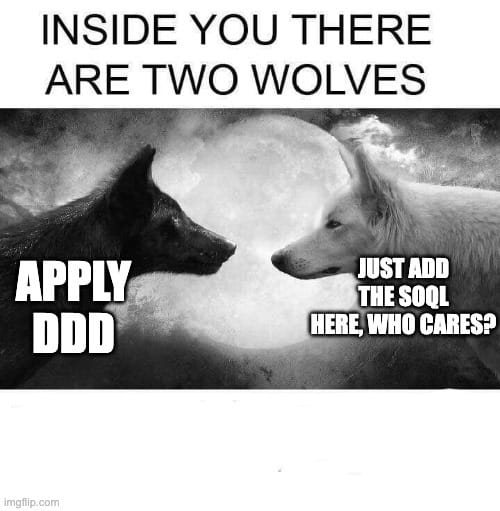- SalesforceChaCha
- Posts
- 💃 A strategy to tame complex business logic 🕺
💃 A strategy to tame complex business logic 🕺
Domain-Driven Design (DDD) in Salesforce
Good morning, Salesforce Nerds! How’s your latest project going? 🤔
We all know Salesforce projects often start simple - a few custom objects, a handful of automation rules, and some Apex classes to glue things together.
But before you know it, your org is a sprawling mess of triggers, flow spaghetti, and an Apex monolith that makes debugging a nightmare. 😮💨
It can feel like project after project, client after client the story is the same.
So how do we avoid this?
One way is a concept called Domain-Driven Design (DDD), a software design approach that can bring order to this chaos. 🔥
Let’s dig in!

TABLE OF CONTENTS
A strategy to tame complex business logic
MAKING SENSE OF THE MADNESS
WHAT IS DOMAIN-DRIVEN DESIGN (DDD)?
Domain-Driven Design (DDD) is a software design philosophy that emphasizes structuring applications around the core business domain. 📦️
Instead of forcing business logic into a technical framework, DDD ensures that the system mirrors real-world business concepts, making it more maintainable, scalable, and understandable.
These are good things if you’re not sure! 😉
At its core, DDD is about:
⬇️ Understanding the business domain deeply
🧩 Organizing code around domain concepts
🎁 Encapsulating business rules within domain models
🤝 Improving collaboration between developers and domain experts
BECAUSE YOUR ORG DESERVES BETTER
WHY DOES IT MATTER?
Salesforce, by its nature, is a highly customizable platform that often becomes a dumping ground for ad-hoc solutions.
Without a structured approach, technical debt accumulates quickly. 💨
Applying DDD principles to Salesforce development can help:
👍️ Reduce complexity by grouping related logic within domain models.
🏗️ Improve maintainability by keeping code modular and reusable.
🤝 Enhance collaboration between technical and non-technical stakeholders.
📈 Scale effectively by designing a system that evolves with business needs.
THE MORE YOU KNOW
CORE CONCEPTS
📦️ Bounded Contexts: Keeping Responsibilities Clear
Salesforce orgs often have multiple departments (Sales, Service, Finance) that share the same data model but operate differently. 🥴
A Bounded Context helps define clear boundaries for different parts of the system, ensuring that logic relevant to Sales doesn’t interfere with Finance workflows.
Salesforce Example:
A
Leadrecord may have different validation and conversion processes in Sales Cloud than in a custom partner portal.Instead of a single bloated
LeadServiceclass, split it intoSalesLeadServiceandPartnerLeadService.
ℹ️ Entities and Value Objects: Structuring Your Data
Entities are objects with distinct identities (e.g.,
Account,Opportunity).Value Objects are objects that don’t have an identity but carry information (e.g., an
Addresson an Account record).
Salesforce Example:
Instead of storing address data as plain text fields on an Account, create a
Custom Metadata TypeorCustom Objectfor addresses, making it reusable across multiple entities.
🧩 Aggregates: Controlling Data Integrity
An Aggregate is a group of related entities that should be treated as a single unit. 1️⃣
One entity (the Aggregate Root) manages consistency across the group.
Salesforce Example:
An
Opportunityand its relatedOpportunityLineItemsform an Aggregate. Business rules ensuring line item integrity should reside within anOpportunityServiceclass rather than scattered across triggers and flows.
🔄 Domain Services: Keeping Logic Where It Belongs
Not all business rules belong inside an entity. 🚫
Domain Services handle operations that involve multiple entities.
Salesforce Example:
Instead of putting discount validation logic in multiple places, encapsulate it in an
OpportunityPricingServiceclass.
🔍️ Repositories: Abstracting Data Access
Repositories provide a clean interface for retrieving and persisting domain objects without exposing implementation details. ✨
Salesforce Example:
Instead of writing SOQL queries directly in controllers or triggers, create a
CustomerRepositoryApex class to handle retrieval logic for Accounts and Contacts.
GIVE YOUR ORG A MAKEOVER
APPLYING DDD IN SALESFORCE
Alright, so you’re convinced - DDD isn’t just some fancy enterprise jargon, and you want to bring its magic to your Salesforce org. 🪄
But how do you do it without ending up in an existential crisis over your data model?
Don’t worry; applying DDD in Salesforce isn’t about over-engineering. It’s about bringing structure and sanity to your org before it turns into a spaghetti-coded monolith. 🍝
Here are some ideas to get started 👇️
🗳️ Modularize Your Codebase
Break apart monolithic trigger handlers into domain-specific services. Use Apex classes to separate concerns and keep logic cohesive.
😃 Use Custom Metadata for Business Rules
Hardcoding rules in Apex makes maintenance painful. Store business rules in Custom Metadata Types (CMTs) so they can be changed without deploying code.
🧪 Implement Unit Tests with DDD in Mind
Write tests that validate domain logic rather than focusing solely on DML operations.
📩 Design APIs with DDD Principles
When exposing Salesforce data via APIs, keep endpoints aligned with domain models rather than exposing raw Salesforce objects.
FINAL THOUGHTS
CONCLUSION
DDD provides a structured way to design complex Salesforce implementations while keeping business logic clear and maintainable. 🏗️
By embracing DDD principles, you can transform your org from a tangled mess of automation into a well-architected, scalable system that grows with the business.
So the next time you're about to cram another trigger into your already overloaded AccountTriggerHandler, take a step back and think:
💃 Would DDD do it differently? 🕺
Happy coding!
SOUL FOOD
Today’s Principle
"The hardest part of design is keeping features out."
and now....Salesforce Memes



What did you think about today's newsletter? |